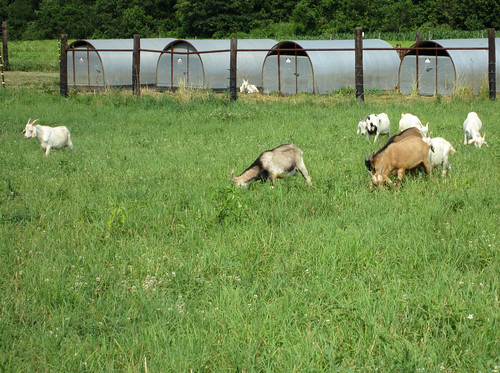For the samples collected on July 12, fecal egg counts ranged from 0 to 7266 and averaged 818 ±1104 eggs per gram (of feces). The median egg count was 575 epg. Two weeks prior, egg counts averaged just 237 epg, and the median count was 59 epg.
On July 12, only 8 goats (or 16 percent) had egg counts above 1,000 epg, the test's Gold standard for parasite resistance (for high egg count). Only two goats had egg counts above 2,000, the test's Bronze standard for parasite resistance (for high egg count).
Some samples contained coccidia (Eimeria sp.) oocytes and tapeworm (Monieza sp.) eggs. Not all species of coccidia are pathogenic. Tapeworms are not usually pathogenic (disease or symptom-causing).
For the pooled sample collected on June 28, Haemonchus contortus (the barber pole worm) comprised 95 percent of the worm load. The remaining eggs (larvae) were a 4 percent mixture of Trichostrongylus and Teladorsagia and a 1 percent mixture of Oesophagostumum and Ostertagia.
Upon arrival to the test site, the worms in the goats were 71 percent Haemonchus contortus, 16 percent Trichostrongylus, and 13 percent other (Oesophagostumum and Ostertagia).
The conditions are ideal for worms: warm and moist. Egg counts should continue to climb and the barber pole worm should continue to dominate the parasite infection. Some goats are bound to require deworming.
Anemia as estimated by the FAMACHA© card is the primary symptom of barber pole worm infection. Bottle jaw has been observed rarely in the goats in the test.
Another pooled sample, along with individual samples, will be collected on July 26.
Download July 12 FEC report -- updated 07.27.11
On July 12, only 8 goats (or 16 percent) had egg counts above 1,000 epg, the test's Gold standard for parasite resistance (for high egg count). Only two goats had egg counts above 2,000, the test's Bronze standard for parasite resistance (for high egg count).
Some samples contained coccidia (Eimeria sp.) oocytes and tapeworm (Monieza sp.) eggs. Not all species of coccidia are pathogenic. Tapeworms are not usually pathogenic (disease or symptom-causing).
For the pooled sample collected on June 28, Haemonchus contortus (the barber pole worm) comprised 95 percent of the worm load. The remaining eggs (larvae) were a 4 percent mixture of Trichostrongylus and Teladorsagia and a 1 percent mixture of Oesophagostumum and Ostertagia.
Upon arrival to the test site, the worms in the goats were 71 percent Haemonchus contortus, 16 percent Trichostrongylus, and 13 percent other (Oesophagostumum and Ostertagia).
 |
| Close grazing can lead to worm problems. |
The conditions are ideal for worms: warm and moist. Egg counts should continue to climb and the barber pole worm should continue to dominate the parasite infection. Some goats are bound to require deworming.
Anemia as estimated by the FAMACHA© card is the primary symptom of barber pole worm infection. Bottle jaw has been observed rarely in the goats in the test.
Another pooled sample, along with individual samples, will be collected on July 26.
Download July 12 FEC report -- updated 07.27.11











